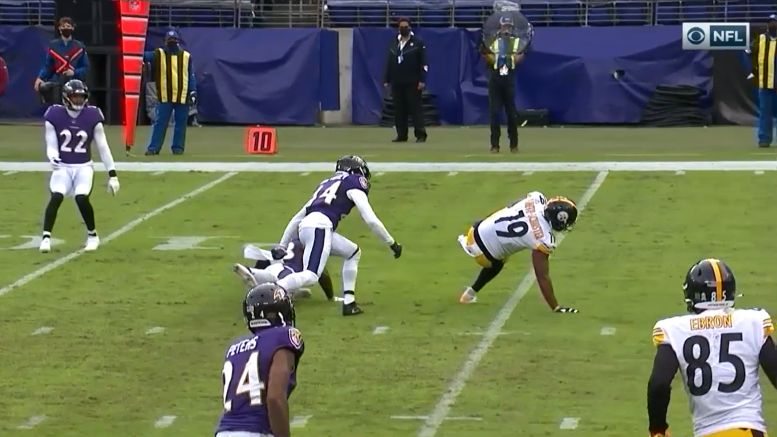The Pittsburgh Steelers followed a ball-control strategy last week to ground one of the NFL’s top rushing offenses last week against the Tennessee Titans. Ben Roethlisberger suggested that they would try to do the same on Sunday against the Baltimore Ravens, who entered the day leading the league in rushing yards. It did not go nearly as smoothly.
The offense could hardly get out of its own way, mustering just 65 yards in the first half, with hardly anything happening in the passing game, the best play here ending up resulting in a lost fumble. They did manage 42 yards on the ground, but with minimal sustainability.
By the end of the half, the Steelers controlled the ball for fewer than 10 minutes, and trailed by 10 points, 17-7, and it was the defense with a pick six on the third play of the game that spotted them their only points of the opening two frames.
Part of the reason for this was because the Ravens themselves were successful in executing a sustained possession offense—this in spite of the fact that they gave the ball away twice, including a fumble by Lamar Jackson in the red zone when Bud Dupree got to him from behind. Things would likely have looked even worse if not for that.
It wasn’t until the second half that the Steelers were able to sustain much of anything, even if they only had two truly sustained drives in the half. One drive spanned 77 yards, the other going for 80, and both of them wound up in the end zone, but they finally allowed the defense to get some rest.
The two teams roughly split the time of possession in the season half after the Ravens had a two-to-one edge in the first, and that, I suppose, was a small victory. The Steelers did go three and out on two of their three final possessions, and that nearly proved costly in the end, but the Ravens were the ones who ultimately ran out of time.
And this is a week after it was Pittsburgh that dominated time of possession, accounting for over 15 minutes on just their first two drives alone. Against the Tennessee Titans, they ultimately controlled the ball for 36:37. The week before that, against the Cleveland Browns, they held an edge at 34:06, and that was with a defensive score.
It must have been nice for the defense to be playing 25-minute games, but this week they basically had to play overtime, the time of possession being flipped. Of course, whenever this happens, there is blame to go around on both sides of the ball, but what’s clear is that the offense was severely lacking in this area in the first half, and contributed to their 10-point hole by halftime.








